|
Hibernation Boxes for Butterflies
 A butterfly house makes a great addition to the home garden. It not only provides the butterflies with shelter from predators and bad weather, but also adds an eye-catching and lively element to the garden. Travelling butterflies need a place where they can rest. A butterfly house protects the butterflies from wind, cats, rain and birds. A butterfly house makes a great addition to the home garden. It not only provides the butterflies with shelter from predators and bad weather, but also adds an eye-catching and lively element to the garden. Travelling butterflies need a place where they can rest. A butterfly house protects the butterflies from wind, cats, rain and birds.
Butterfly houses look similar to bird houses. A bird house has an entrance in the shape of a hole, while a butterfly house has a thin opening as its entrance.This entrance is several inches in length and a centimeter wide. This ensures that birds and other animals cannot get in.
They are usually made of wood and painted with bright colors which are said to serve as an attraction. Butterflies see colors differently than we do with their compound eyes. Everything is seen as an intricate mosaic. In North America butterflies prefer the color Purple, Pink, Yellow,White, Blue and Red - in this order. Purple and yellow are exceptional to drawing butterflies to boxes.
In nature butterflies seek shelter under trees, leaves, fences, hiding in other vegetation and under eaves of houses. The long, narrow openings in front of butterfly boxes are designed to mimic a crevice or hollow tree opening. Optimal areas for placement of butterfly houses can be on the outskirts of property where there is likely to be a cluster of trees and plenty of shade. It is also a good idea to have butterfly host plants and nectar sources close by. One can place a small dish of sugar water inside, or on the ground beneath the butterfly house. The house should be placed on a pole or tree, four feet or more off the ground. Butterflies seek weeds as host plants just the same as they would plants from your garden. Weeds can also have flowers that provide nectar sources. So your chosen area may include weeds already present or selective weeding which is maintained. Using vegetation native to your geographic area encourages native butterflies to visit. In time you will see more species of butterflies flying by.
Seeing birds feed and take shelter with bird houses, it is assumed that butterflies will come and go just the same with their houses. Actually the better term to describe a butterfly house would be hibernation box. The history behind these boxes goes back to Scotland where many butterflies hibernate, or overwinter, in the adult stage.
Don't be discouraged if you don't get immediate occupancy. This can take time. Helping to encourage a butterfly flying by to stop can be to combine the house to a butterfly feeder. Butterfly feeders would provide nectar sources for them to feed upon and can be as easy as placing fruit out.
Come in and see our selection of butterfly hibernation boxes. We also have butterfly feeders and a selection of books to help you develop a butterfly haven in your backyard.
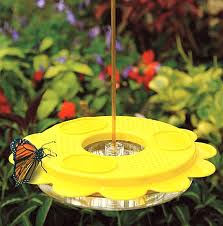 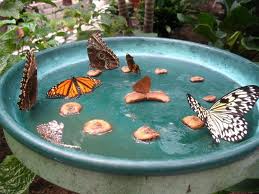 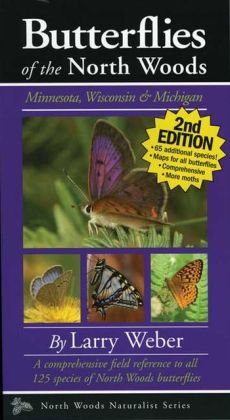 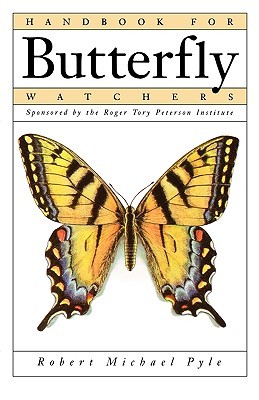 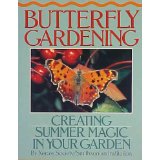
Garden Friends - TOADS
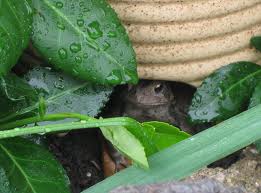
Invite a toad to live in your garden and you won’t regret it. Toads prey upon insects, slugs and snails – 100 or more every day, that's up to 10,000 in a single summer. If you are battling the Battle of the Bug in your yard, having a toad in your garden reduces the need for harmful, chemical-laden pesticides or labor-intensive natural control of these pests. Providing a habitat for a toad ensures that this amphibian will stick around to help out with your pest control chores. Provide plenty of foliage and a slightly higher place where it will feel safe from its natural predators – birds, snakes and the occasional roaming cat or dog. Toads need a moist place to live – a toadhouse would make a cute and beneficial addition to your garden while providing a cool, moist, safe haven for your resident garden toad. Wildbird &Backyard currently has a large and varied supply of toad houses, one that would be a perfect addition to your backyard. Having a toad in the garden is a natural blessing to the gardener.
Bird Questions and Answers
Cornell Lab of Ornithology Answers Bird Questions
Q. I've been hearing beautiful bird songs every morning since spring, but suddenly I'm not hearing birds at all! What happened to them?
A. Birds sing for two basic reasons associated with nesting: to attract a mate and to defend a territory. By July, many baby birds have fledged, and adult birds are busy feeding them and teaching them how to find their own food and other survival skills. At this point, species that raise only one family a year may stop singing altogether, but some have a brief resumption of song, which may help teach the young of those species their local song dialect. But overall, one by one, each species drops out of the spring chorus until by late July, only a handful of birds are still singing at all. One of our most noticeable backyard songsters, the American Robin, may renest several times from its arrival in early spring through summer, but even robins don't start new nests after late July or at the latest early August. At this point, they stop feeling territorial and join sociable feeding flocks, and territorial singing is just not compatible with flocking.
Ironically, this silence and secretive behavior as birds raise their fledglings and then molt makes them least conspicuous right a the time of year when birds are most abundant, when populations of adults are augmented by all the young birds they produced this year. By spring, bird numbers are greatly reduced after losses during two migrations and over winter, but that's when they're most conspicuous thanks to that rich singing.
Q What is the difference between a beak and a bill?
A: Not a thing--the words are synonymous. Ornithologists tend to use the word "bill" more often than "beak," and we personally tend to use "beak" most when referring to songbirds with pointed bills, but we've seen both words used in reference to a wide variety of species.
One important caveat: if you tell that old joke about the duck going into the drugstore to buy some chapstick, and the cashier asks how he's going to pay for it and the duck says, "put it on my bill"—well, that joke just doesn't work if you say "beak."
Squawk's Favorite Number
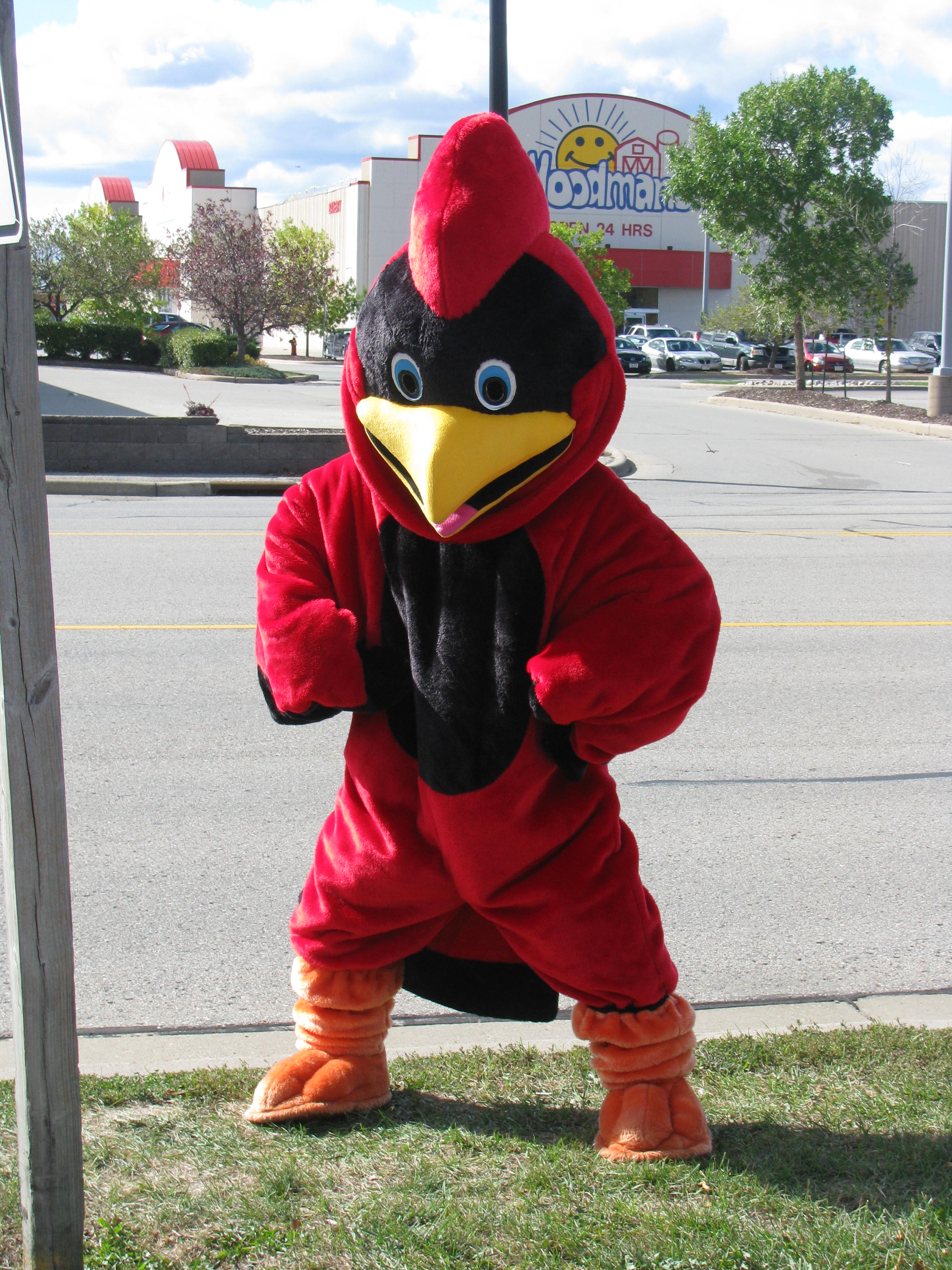 Our mascot, Squawk, came back for a visit (it's been a year since Squawk was at Wildbird & Backyard) to celebrate the relocation to Westhill Boulevard. During the month of June we asked our customers what number Squawk was thinking about and to enter that number into our contest. Well, if you looked intently at the poster, there were 5 question marks circling above Squawk's head, 3 were small and 2 were large; he was thinking of the number 32! Michelle VandenBoogard was the only entry to guess the number 32 and she is our winner. Congratulations to Michelle, the winner of a $50 Gift Card to Wildbird & Backyard. Our mascot, Squawk, came back for a visit (it's been a year since Squawk was at Wildbird & Backyard) to celebrate the relocation to Westhill Boulevard. During the month of June we asked our customers what number Squawk was thinking about and to enter that number into our contest. Well, if you looked intently at the poster, there were 5 question marks circling above Squawk's head, 3 were small and 2 were large; he was thinking of the number 32! Michelle VandenBoogard was the only entry to guess the number 32 and she is our winner. Congratulations to Michelle, the winner of a $50 Gift Card to Wildbird & Backyard.
Summer Selection for your Backyard
Here's a selection of products that are designed with summer in mind:
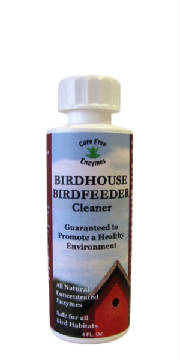 Birdbath, Birdhouse and Birdbath Cleaners: Soy based cleaners that are easy to use and safe for the environment, no toxic ingredients that are harmful to the birds or other backyard visitors. These products are concentrated and a little goes a long way. Birdbath, Birdhouse and Birdbath Cleaners: Soy based cleaners that are easy to use and safe for the environment, no toxic ingredients that are harmful to the birds or other backyard visitors. These products are concentrated and a little goes a long way.
 Plant Saver: A proven formula deters animals from eating your plants. Developed right here in Wisconsin with natural ingredients, no foul order, endorsed by the National Gardeners Association. One application lasts a full growing season when applied around garden plants. Plant Saver: A proven formula deters animals from eating your plants. Developed right here in Wisconsin with natural ingredients, no foul order, endorsed by the National Gardeners Association. One application lasts a full growing season when applied around garden plants.
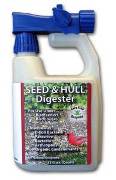 Seed and Hull Digester: Attach this product right to your garden hose and every other week spray around the base of your bird feeders. This product will help decompose any seed hulls under your feeder, is non-toxic to the birds and other animals and will help destroy bacteria. Safe and easy to use. Seed and Hull Digester: Attach this product right to your garden hose and every other week spray around the base of your bird feeders. This product will help decompose any seed hulls under your feeder, is non-toxic to the birds and other animals and will help destroy bacteria. Safe and easy to use.
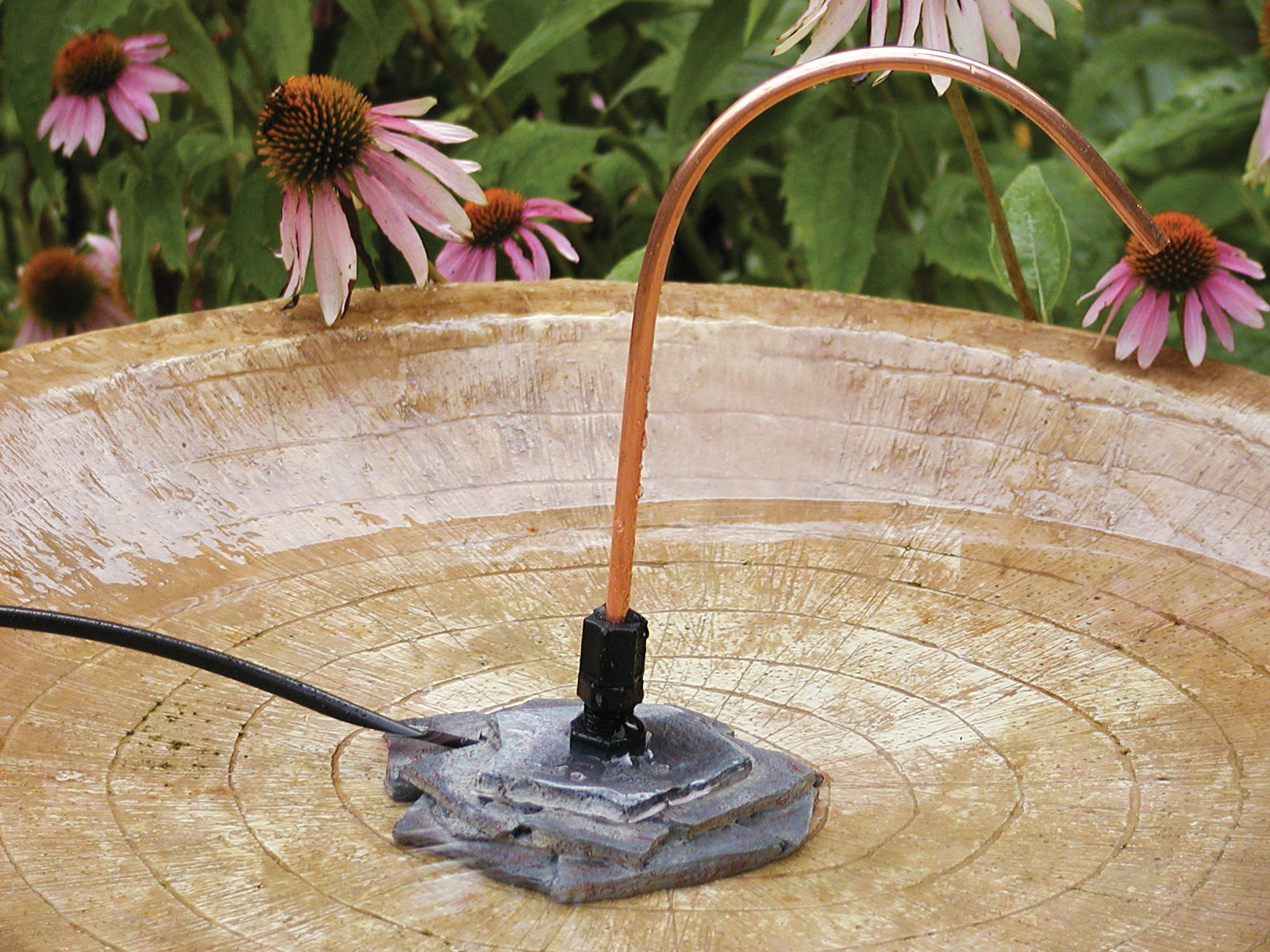 Drippers, Misters and Recirculating Rocks: Attach or place these drippers, misters or rocks into your bird bath to either introduce clean, fresh water and/or to keep the water circulating and moving. We have a selection of different models that either include hosing to attach to your water faucet or plug into an electrical outlet. Drippers, Misters and Recirculating Rocks: Attach or place these drippers, misters or rocks into your bird bath to either introduce clean, fresh water and/or to keep the water circulating and moving. We have a selection of different models that either include hosing to attach to your water faucet or plug into an electrical outlet.
 Water Wiggler: Using the power of 2 batteries, the Water Wiggler will keep the water in your birdbath moving, attracting more birds and preventing mosquito eggs from developing. No faucet or electricity needed with this unit. Water Wiggler: Using the power of 2 batteries, the Water Wiggler will keep the water in your birdbath moving, attracting more birds and preventing mosquito eggs from developing. No faucet or electricity needed with this unit.
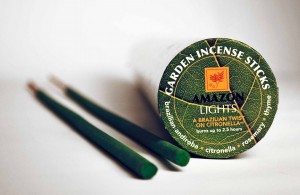 Amazon Lights: Garden incense candles and sticks made from all natural ingredients to deter insects from attacking you while you enjoy your summer days outside. These products are an effective and aromatic blend of brazilian andiroba, citronella, rosemary and thyme. Amazon Lights: Garden incense candles and sticks made from all natural ingredients to deter insects from attacking you while you enjoy your summer days outside. These products are an effective and aromatic blend of brazilian andiroba, citronella, rosemary and thyme.
 Bee and Wasp Traps: These attractive glass containers, when holding a sweet liquid, will attract bees and wasps who will enter into the container and not be able to exit. Safe and easy to use, nothing toxic, just an attractive jar to place in your backyard. Several styles and colors are available. Bee and Wasp Traps: These attractive glass containers, when holding a sweet liquid, will attract bees and wasps who will enter into the container and not be able to exit. Safe and easy to use, nothing toxic, just an attractive jar to place in your backyard. Several styles and colors are available.
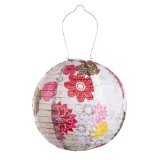 Solar Patio Lanterns: New this year, a beautiful lantern to bring a soft light to your backyard. The solar panel on the top with give the lantern a soft glow once the sun has set. These lanterns can actually be used year round, even in our climate, and can be cleaned with a mild cleaner if needed. Solar Patio Lanterns: New this year, a beautiful lantern to bring a soft light to your backyard. The solar panel on the top with give the lantern a soft glow once the sun has set. These lanterns can actually be used year round, even in our climate, and can be cleaned with a mild cleaner if needed.
Mike's Message
July begins our second year at our new Westhill location. This past year was simply terrific – we have been busy with increased traffic and sales in the store. Our store and Breadsmith have so many of the same customers, chatting and “feeding off” each other (no pun intended). We couldn’t be happier.
On the down side, Dave, my dear friend of 40 years, retired from our store at the end of June. Dave was loved by our staff and customers and will be truly missed, especially by me. We all wish him well and now I’m looking forward to spending time with him on my day off, fishing together, just like old times. We haven’t done that in a long time as Dave and I never had the same day off together.
On the up side, Cathy Staeven has agreed to take over Dave’s hours and responsibilities. Cathy has been with us for almost a year and she is simply a delight. Her smile and humor is infectious and she’s been a true asset to our store – she even contributed the Toad article for this newsletter. Thanks, Cathy and congratulations.
With all this shifting we are still one person down in the store and are looking for someone to fill this position. If you are interested in joining us, this part time position is for a few hours during the week along with one weekend a month. Come talk to me – it really is a fun place to work.
A bird phenomenon seemed to occur last summer and is seemingly with us this year as well. Many people are asking, “Where did my goldfinches go?” The goldfinches are not eating nyger seed like they did in years past. It appears they are more attracted to sunflower chips. Their change in appetite has required me to change the seed mix formula in our Finch Mix – now the prime ingredient is fine sunflower chips instead of nyger. If you are experiencing the lack of goldfinches in your yard, try switching to the new Finch Mix.
Another common dilemma is the return of the grackles. They seem to be worse than ever this year. My thought is that the wet, late spring delayed farmers from planting on their normal schedule. The crops are way behind, so possibly the grackles have no natural agricultural food source and are staying longer on bird feeders. There are two solutions: provide ONLY safflower or nutrasaf seed or use only a feeder designed to keep them off. I wish I had more answers for that feeding issue, but there aren’t any. The grackles usually are only with us until late September.
Thank you all for your continued support and I wish all of you a happy and safe summer.
Happy Birding, Mike
|